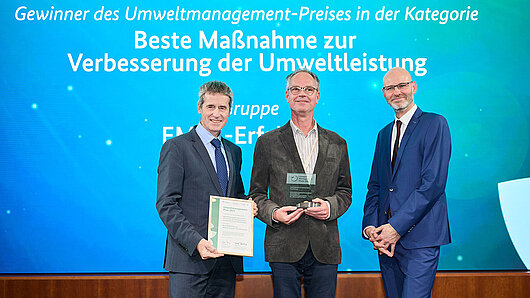High-Performance Computing Center Stuttgart

The prize was presented in the Haus der deutschen Wirtschaft in Berlin during the conference “30 Years of EMAS — a Sustainable Success.” The competition is organized by the German Federal Ministry for the Environment, Climate Action, Nature Conservation, and Nuclear Safety (BMUV) together with the Austrian Federal Ministry of Agriculture and Forestry, Climate and Environmental Protection, Regions, and Water Management (BMLUK).
“We are extremely happy about this award, which underlines our engagement in sustainable computing and responsible energy management,” said Prof. Dr. Michael Resch, Director of HLRS. “With PowerSched we are demonstrating that supporting both cutting-edge research and climate protection is no contradiction. Rather, they strengthen one another.”
In 2024 HLRS began using a method for dynamic power capping developed in cooperation with HPE — PowerSched — on Hawk’s production environment. PowerSched distributes available power across a supercomputer’s compute nodes in a targeted manner. How much energy each node receives depends on which application is running on it at a given time. Computationally intensive programs receive more power, while memory bound applications are assigned less energy. The system continuously monitors and regulates the distribution of power in order to maintain an optimal balance at all times. This enabled Hawk to use available energy as efficiently as possible and to respond flexibly to changes in the computing center’s energy and load budget.
By implementing this method, HLRS was able to reduce the power needs of its supercomputer by approximately 0.8 Megawatts. These savings are comparable to the annual power usage of approximately 1,500 single-family homes.
HLRS’s use of PowerSched is part of a comprehensive sustainability strategy, which also includes construction of a new, particularly energy-efficient data center called HLRS III and the use of all waste heat to supply the University of Stuttgart’s Vaihingen campus. In the future, HLRS plans to implement PowerSched on GPU-based systems, including its current high-performance computer, Hunter, and its future supercomputer, Herder, which is scheduled to go into operation in 2027.
“As the first EMAS-validated high-performance computing center in Europe, we see it as our responsibility to pioneer new approaches for sustainable technologies,” added Dr. Norbert Conrad, environmental management officer at HLRS. “Receiving the Environmental Management Prize confirms that we are on the right path.”
HLRS openly publishes knowledge gained through its efforts to improve sustainability, making it publicly accessible for other data centers and research institutions. In this way, the center makes important contributions to the reduction of energy usage across the entire field of scientific high-performance computing. HPE will also integrate the core concepts behind PowerSched into its HPE Cray Supercomputing User Services software. In the future, this will enable HPE-Cray clients to implement comprehensive energy management.
— Sophia Honisch